The Guildhall Art Gallery’s latest exhibition, Treasures of Gold and Silver Wire exhibition, showcases the exquisite use of gold and silver wire in the fields of embroidery, ecclesiastical and ceremonial dress and in jewelry making through the centuries, and is the perfect way to get you in the mood for a sparkling Christmas.
The exhibition has been extended to 31 December and I was lucky enough to have a guided tour with Dr Karen Watts, the curator responsible for putting the exhibition together on behalf of The Worshipful Company of Gold and Silver Wyre Drawers (GSWD).
400th anniversary of GSWD’s Charter
The exhibition is a celebration of the 400th anniversary of The Worshipful Company of Gold and Silver Wyre Drawers receiving its charter from James I in 1623 and has over 270 exhibits on display including such jaw-dropping items as Darcy Bussell’s tutu, Oliver Cromwell’s dressing gown (allegedly), Elizabeth II’s Coronation glove and Charles Dickens’s court dress.
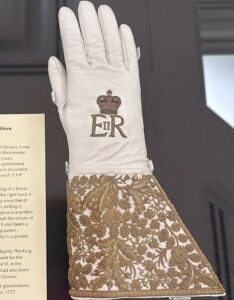
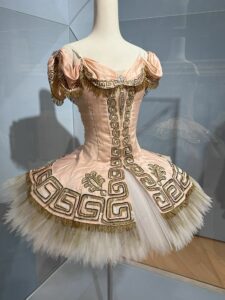
You may wonder what exactly are gold and silver wyre drawers? These are the craftspeople who create gold and silver wire used in embroidery and on garments by drawing (i.e. pulling) the metal through increasingly smaller holes in a drawplate to make gold and silver wire, the finest being the width of a human hair. The wire is then wrapped around thread and can be used in embroidery and even crocheted or woven into cloth or made into ribbons or coils for use on epaulettes.
Henry VIII’s meeting with Francis I in 1520 at the Field of the Cloth of Gold was so called due to the copious amount of gold cloth displayed, woven from gold and silver thread. The livery company is still involved in promoting the craft providing grants and scholarships to students and makers.
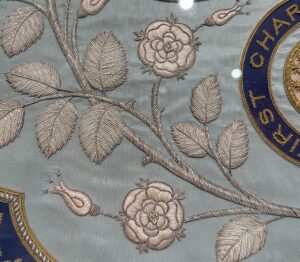
Medieval Marvels
The exhibition took Dr Watts five years to put together with the help of experts in the fields of embroidery and jewelry and consists of three rooms, the first of which traces the history of goldwork from the Middle Ages. This room contains two of the most treasured examples of early embroidery, one of which is the Bacton Cope, an ecclesiastical garment made using cloth from a dress worn by Elizabeth I, and illustrates a theme of the exhibition, namely how fine examples of goldwork were often recycled into later pieces.
The second treasure is the Fishmonger’s Pall, used to cover the coffins of important members of the Worshipful Company of Fishmongers, and decorated with pictures of mermaids, mermen, St Peter and Christ. Dr Watts and I agreed that in the event of a fire if we could only save one item, we would both save the Fishmonger’s Pall – the Bacton Cope luckily being encased in a climatically controlled fire-proof case.
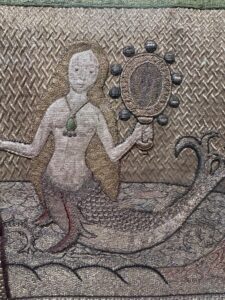
Ceremonial Dress
The second room is devoted to royal regalia, seen so recently at the Coronation of Charles III, and military and ecclesiastical clothing, as well as costumes from the performing arts. The standout piece here has to be the Jubilee Cope, designed by Bery Dean, the renowned embroiderer who reinvigorated the art of embroidery in the last century, and depicting St Paul’s Cathedral and 73 London Churches.
The design and colour palette was devised by Beryl Dean, but the actual churches were embroidered by her students and then appliqued onto the cope. Dr Watts tells the story of how one unfortunate student after having spent a month creating their two embroidered churches, left the pieces on the train – and had to recreate them in two weeks!
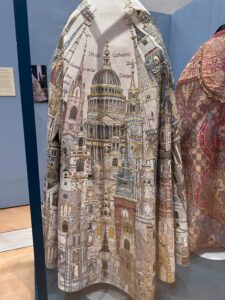
The exhibition rightly highlights the women who helped preserve this craft and includes the altar cloth embroidered by pupils from the school established by Lady Marian Alford, who cut up her wedding dress for use in the piece. Queen Mary’s Coronation gown is also on display, embroidered by pupils from the two embroidery schools established by Princess Louise, Queen Victoria’s daughter.
Gold and Silver Wire today
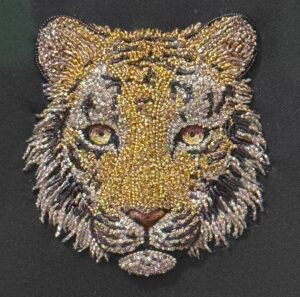
The final room shows the modern uses of gold and silver wire with examples of work by modern embroiderers and jewelry makers – some of whom make their own gold and silver wire as so few wire drawers remain in Britain. These pieces will have you reaching for your phone to google the makers to see if you can afford any of the pieces yourself – but if your purse doesn’t quite stretch to this, the exhibition is a chance to spend time marveling at the exquisite craftsmanship of British makers through the ages.
Dr Karen Watts is a professional curator and trains curators at the Ecole de Louvre and is available for private tours. Ildiko is one of the guides providing free tours of the permanent collection at Guildhall Art Gallery.


